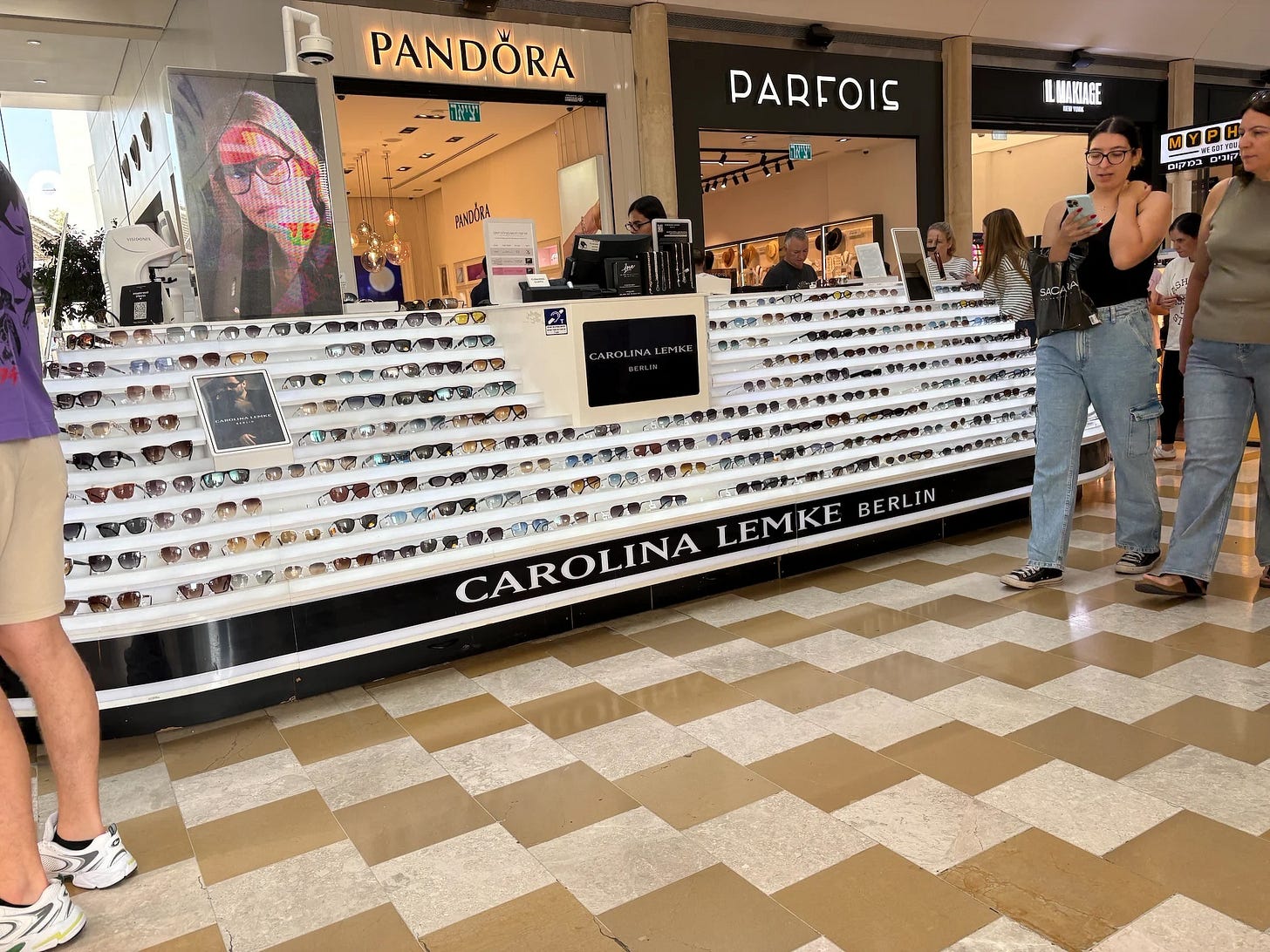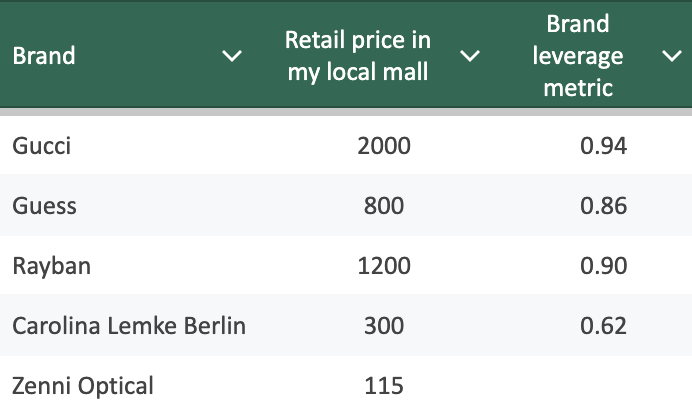The 5 step hack to Brand Power if you’re a super model
Why do we buy Brands: For good feeling or good value?
My tenor. The Selmer Mark VI is Brand Power for over 60 years.
Welcome to Clear Thinking — the go-to newsletter for investors, founders, and senior executives at the intersection of AI, technology, and biology.
Join 950+ industry leaders across the US, Israel, and Europe — including decision-makers from Merck, IQVIA, Medtronic, Flatiron Health, and Debiopharm.
Subscribe to stay ahead of the trends shaping how technology is disrupting biology.
Intro
In his 2016 book 7 Powers: The Foundations of Business Strategy, Hamilton Helmer looked at companies like Netflix and Pixar and developed a toolkit to create Power and build moats.
In Part 1 of this series, I talk about “founder–market misfit”.
In Part 2, I answer the question of how to choose your powers.
In Part 3, I talk about Switching Costs.
This week: branding — how it helps you charge more for the same thing.
Today, I’ll analyze 3 examples of superior branding. I’ll introduce a brand leverage metric and conclude with the limitations of branding.
I’ll give you a 5 step hack to synthesize your own brand.
Every enduring brand does two things at once — it reduces uncertainty and increases affective valence.
In plain English: it makes you feel safe, and it makes you feel good.
We buy a brand because of the emotional attraction and because it’s a safe choice.
Let’s analyze 3 cases - diamonds, eyewear and saxophones to understand the Power called Branding.
We’ll start with a quick review of the 7 powers.
The 7 Powers in Short
Scale Economies — Unit costs decline as production volume increases due to fixed cost spreading and operational efficiencies. Barriers rise when competitors can’t match your volume economics.
Network Economies — Product value increases as more users join the network. Each additional user makes the product more valuable for everyone. See The Network Effects Bible for a detailed treatment of the different kinds of network effects.
Counter-Positioning — A newcomer adopts a superior business model that incumbents can’t copy without damaging their existing business. The incumbent faces a “damned if you do, damned if you don’t” dilemma.
Switching Costs — Customers face high financial, time, or risk costs when changing suppliers, keeping them loyal even when alternatives exist.
Branding — Customers attribute higher value based on reputation and trust, not just product features.
Cornered Resource — Exclusive access to a critical asset (data, talent, IP, relationships, raw materials) that others can’t easily obtain.
Process Power — Organizational capabilities and methods that enable superior operations and are difficult for competitors to replicate — often built through years of learning and refinement.
The Brand leverage metric
Let’s try and estimate branding power as a function of price multiple that a brand can command.
Assuming costs are marginal (or equivalent) between competitors:
Leverage = 1 - 1/B. where B = price multiple of the brand vs the unbranded competitor
For example: a Louis Vuitton bag costs $5,000. A similar unbranded bag costs $500: Leverage = .9
Diamonds Are Forever — Tiffany & Co.
The 4Cs of diamonds: cut, clarity, color, carat.
After our FinTech startup crashed, I became a security consultant.
One of my clients was Martin Rapaport — founder of the Rapaport Diamond Report (“the Rap Sheet”).
Martin rose to industry fame in 1978 by publishing wholesale diamond prices during the 1979–80 commodity boom, when 1.00-ct D Flawless stones hit $36,000. Before the Rap Sheet, deals were done on a handshake and the phrase Mazal u’Bracha — luck and blessing.
Rapaport was sued and blacklisted by the diamond club, but his price sheet became the industry standard.
He commoditized diamonds by creating transparent pricing. Once buyers could comparison-shop, single-brand pricing power dropped.
In 2005, Good Morning America bought two rings — a $16,600 Tiffany ring and a $6,600 Costco ring. A gemologist valued the Costco ring at $8,000 and the Tiffany ring at $10,500. (Helmer, p.109)
So how does Tiffany command a 2.5x premium for the same 4Cs?
Because Tiffany makes you feel safe — and feel good.
Founded in 1837, Tiffany spent nearly two centuries cultivating that feeling. Their site says it best:
“Today, Tiffany Blue® and the iconic Blue Box embody the joy of giving and the excitement of receiving… a vessel coveted not only for what it holds but for what it represents.”
Brand leverage = 1 – 6600/16600 = 0.602
The 5 step hack to an international brand (if you’re a super model)
Carolina Lemke Berlin is a fascinating case study in creating a “from-zero heritage” brand — where the story (Berlin designer, cosmopolitan energy) was engineered first, and the operations (Israeli eyewear retail) came later.
Carolina Lemke Berlin is a virtual retail eyewear brand created by Israeli supermodel Bar Rafaeli and operated by Israel retail conglomerate Castro.
Here’s how it works — and why it’s brilliant marketing.
I’ll give you a 5 step plan to make your own brand from zero.
Step 1 - Use a place, not a person. The Carolina Lemke eyewear brand started with a place, not a person
Instead of rooting the brand in a founder’s biography (like “Ray-Ban”), they rooted it in Berlin — shorthand for edgy, creative, urban Europe. This gave them instant cultural equity without needing 188 years of history like Tiffany.
Step 2 - Design a backstory. Calling the brand Carolina Lemke sounds authentically European, feminine, and high-fashion. It gives journalists, influencers, and retailers a name for a story. The trick is to give the market a believable narrative without too many details.
Step 3 - Use a celebrity founder. Bar Refaeli is the face and investor in the brand to this day.
It creates immediate social proof.
Step 4 - Control your production and margins. Unlike distribution models, Carolina Lemke keeps design, manufacturing, and retail vertically integrated — stores, online, and celebrity campaigns under one system. That allows Castro (the Israeli retail organization who operates the brand) to apply a Zara-style model to eyewear.
Affordable prices (mid-tier, fast-fashion logic)
Fast trend cycles (product refresh every season)
Brand consistency (no franchise chaos)
Step 5 - Scale your storytelling. Once the aesthetic (”Berlin cool”) and celebrity (”Bar Refaeli”) were set, they exported the brand like a pop song—the story evolved from who made it to how it makes your customer feel.
So does the 5-step hack actually work? I decided to take a field trip to the local mall.
Step 6 - Compute your Brand leverage metric
That’s a picture of Bar Rafaeli over the stand.
Assuming costs are marginal (or equivalent) between competitors:
Leverage = 1 - 1/B. where B = price multiple of the brand vs the unbranded competitor (in this case Zenni Optical - a Chinese online eyewear site)
All prices are in NIS (New Israeli Sheqels)
I tried a few pairs of Carolina Lemke sunglasses, and they are definitely stylish and comfortable compared with Gucci, Guess and Ray-Ban.
The Selmer Mark VI
The Selmer Mark VI tenor and alto saxophones were produced by Henri Selmer Paris during a period of 1954 - 1975. In this time, the Mark VI became a legend for its rich tone, mechanics and ease of playing. The Mark VI became the professional standard played by every major jazz saxophonist - Coltrane, Parker, Rollins, Brecker, Brecker, Wayne Shorter, David Sanborn and over 150,000 saxophone players around the world.
To this day, Selmer’s biggest competitor for its new models is the Mark VI. I have a Mark VI tenor, serial number 106,000 vintage 1963 with the original lacquer and after a professional overhaul. I was offered $20,000 for the instrument.
Leverage = 1 - 1/B. where B = price multiple of the brand vs the unbranded competitor
A Chinese ripoff with the Selmer name costs $400. Leverage = 1 - 400/20000 =0.98
Outro
Branding is a powerful way to charge higher prices, but building true brand power requires either deep time or deep pockets. Tiffany cultivated its brand over 180 years before LVMH acquired it for $15.8B in 2021—a deal that’s proven excellent value as sales have doubled since. Carolina Lemke Berlin took the opposite approach: Castro invested in a supermodel and a Berlin backstory to manufacture heritage in months, not centuries.
But there is a critical distinction: branding helps you charge premium prices, not defeat competitors with an unassailable moat.
The leverage metric reveals the truth. Selmer Mark VI at 0.98 represents near-total brand dominance—musicians pay 50x more for the name alone. That’s probably the highest brand leverage in any category. The Mark VI retained its dominance because Selmer’s subsequent models never matched its tone, quality and mechanics.
Not the first, and not the last to lose their way.
Luxury goods cluster around 0.85-0.95, where the brand is the product. Tech brands hover around 0.5-0.7, where functional differences muddy pure brand power. And Carolina Lemke’s 0.62 sits right in the middle—good pricing power from a brand engineered with the 5 step hack to branding.
The formula captures something elegant: going from 2x to 4x pricing (0.5 to 0.75 leverage) creates more value than going from 20x to 40x (0.95 to 0.975). Diminishing returns kick in fast.
For most TechBio companies, your takeaway is simple: if you can’t command 2x+ pricing on brand alone, you don’t have a brand moat—you have good marketing. Focus your energy on switching costs, network effects, or cornered resources instead.
This Week on Life Sciences Today — Caris & Precision Oncology Alliance
My guest was Dr. James Hamrick, Head of the Precision Oncology Alliance at Caris Life Sciences. Caris is turning 15 years of molecular diagnostics into a data-rich precision oncology network. Through its Alliance—now 97 centers strong with 500K patient profiles—Caris blends genomic and clinical data for discovery and decision support. Under Hamrick’s leadership, the team builds explainable AI tools like GPS AI for cancers of unknown origin, while embedding molecular expertise into care. Next up: clinical decision support, AI transparency, and open collaboration.
Like Tiffany, Caris built its brand by earning trust — in this case, scientific trust. When oncologists see a Caris report, they see credibility, transparency, and time-tested rigor. That’s branding as epistemic certainty.
You can see the episode here
About Me
I’m a 5× founder who learned hard lessons the hard way.
Today, I help TechBio companies maximize their channel revenue and navigate growth, team, and strategy.
My private network is trusted by leaders from Medable, Menarini, Merck, IQVIA, Medtronic, Flatiron Health, Lindus Health, Debiopharm, Unlearn, Cornerstone AI — and 950+ more.
👉 Join here
If you love my writing — share it.
If you want more like this — subscribe





